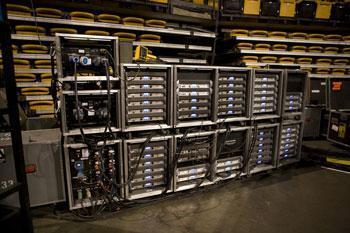How to Choose Racks and Rack Cases
If you’re performing and touring, equipment racks are the professional way to protect your power conditioners, microphone preamplifiers, mixers, processors, wireless gear, and other audio equipment. However, not all racks and rack cases are created equal. This Sweetwater buying guide includes information that can help you choose racks and rack cases for your needs. Since there’s so much to consider when purchasing racks and rack cases for your specific combination of equipment, don’t hesitate to call us at (800) 222-4700 for more information.
Portable Rack Case Types
Rackmounting Tips and Tricks
What is ATA?
Understanding the “U” in Portable Racks
Rack Accessory Necessities
Portable Rack Case Types
Protecting your gear during transport to and from gigs is extremely important. However, you can scale your protection to the types of travel and hazards you’re most likely to face. If you’re moving a small sound system from your home to the coffeehouse once a week, then portable rack bags may be sufficient. They provide compact, lightweight protection from dust and minor scrapes.
Shop for Portable Rack BagsHard cases are designed to protect your gear from the hazards of frequent loading and unloading, such as bumps, collisions with other gear, scratches, dust, and dirt. Some hard cases include shockmounts and are ATA-rated for airline travel. Whether made of plastic, plywood, or some other material, hard cases are a good option for touring groups or those performing several one-night gigs in a week.
Rackmounting Tips and Tricks
The following are a few tips and tricks that will help you install gear in your rack, make your life easier when transporting your rig from gig to gig, and make sure you get the most out of your rack.
Choose the Right Rack Depth
Allow for space behind your rackmount gear and room for any cables/connectors that need to stay plugged in when the rack is closed up. If your gear isn’t very deep, then you may want to consider a shallow-style rack. These will be lighter and save space during transportation. If you’re not sure how much room you’ll need in your rack, just call us at Sweetwater at (800) 222-4700. Tell us what equipment you need to put in the rack, and we’ll help you find the best option.
Balance the Rack
Mount heavier gear toward the bottom of the rack and lighter items at the top. This will help keep the rack balanced, keep it from falling over when it’s moved, and make it easier to carry and lift.
Allow for Airflow
Electronic equipment, especially amplifiers, can generate a lot of warmth. Heat buildup threatens the lifespan of your gear. If a piece of gear such as an amplifier gets really hot, leave at least one empty space above it in the rack to allow for airflow. Heat rises, so arrange the gear in your rack so that the biggest heat-producers aren’t affecting each other. In some cases a rackmountable fan may be necessary to keep things cool.
Convenient Power and Lighting Solutions
Rackmountable power conditioners can provide eight or more outlets in a single rack space. Using one of these strips lets you keep power cable mess to a minimum and means you only need to find one power outlet in order to plug in your rack of gear. Since working on a rack in a dark club or studio can be challenging, many rackmountable power conditioners include retractable lights that can illuminate your rack gear.
What is ATA?
 ATA is the abbreviation for the Air Transport Association. It defines standards for transporting cargo on aircraft. Among those are requirements for approved equipment cases. The ATA designation is found on many case designs. This means that the case conforms to the ATA’s minimum requirements for a case of that size and type. Non-ATA cases can still be used for travel on airlines, but there are limits to the airline’s liability for them and their contents.
ATA is the abbreviation for the Air Transport Association. It defines standards for transporting cargo on aircraft. Among those are requirements for approved equipment cases. The ATA designation is found on many case designs. This means that the case conforms to the ATA’s minimum requirements for a case of that size and type. Non-ATA cases can still be used for travel on airlines, but there are limits to the airline’s liability for them and their contents.
Understanding the “U” in Portable Racks
The width and height of rackmountable equipment is standardized in the audio industry. At the core of this standard is the rack space, or unit. One rack space is defined as 1.75″ from top to bottom and 19″ in width.
Rack Space — Top to Bottom
Rack equipment that is 1.75″ high or some multiple of that conforms to the standard. Equipment height is often measured in rack units, where one unit (1U) is 1.75″, 2U is 3.5″, and so on. Racks are built with holes in their rack rails which correspond to this spacing, allowing for equipment of any unit height to be mounted. If you’re building your own rack, you can purchase rack rails of almost any height.
If you’re not sure how many rack spaces your gear will need, you can use a rack ruler, which is a measuring tape that features rack unit intervals as well as inches.
Rack Space — Left to Right
 From left to right, rack spaces are 19″ wide. Some gear is described as half-rack or third-rack. These sizes allow for multiple pieces of gear to fit in a single rack space (two half-rack units or three third-rack units fit left to right into a rack respectively).
From left to right, rack spaces are 19″ wide. Some gear is described as half-rack or third-rack. These sizes allow for multiple pieces of gear to fit in a single rack space (two half-rack units or three third-rack units fit left to right into a rack respectively).
Rack Accessory Necessities
Rack Screws
![]() While there’s not a lot of tech talk involved with rack screws, it is worth noting that rack screws come with different head types. You can always go with Phillips head rack screws. These are convenient since you probably have a Phillips screwdriver (or three) laying around in your gear bag or car trunk. Square and Torx heads are great choices if you have the tendency to rack, unrack, then rack your gear up again. Why? By design, they’re less likely to strip than Phillips. Lastly, be sure to use washers that won’t scratch your gear (a condition known as rack rash).
While there’s not a lot of tech talk involved with rack screws, it is worth noting that rack screws come with different head types. You can always go with Phillips head rack screws. These are convenient since you probably have a Phillips screwdriver (or three) laying around in your gear bag or car trunk. Square and Torx heads are great choices if you have the tendency to rack, unrack, then rack your gear up again. Why? By design, they’re less likely to strip than Phillips. Lastly, be sure to use washers that won’t scratch your gear (a condition known as rack rash).
Rack Drawers
 Planning for a drawer in your rack might not be vital to great sound, but it sure is a handy place to put all that other stuff that needs to be with your gear such as a mixer tape, Sharpies, your SPL meter, cable tester, remote controls, and hearing protection.
Planning for a drawer in your rack might not be vital to great sound, but it sure is a handy place to put all that other stuff that needs to be with your gear such as a mixer tape, Sharpies, your SPL meter, cable tester, remote controls, and hearing protection.
Rack Shelves
 Sometimes you need gear in your rack that wasn’t designed to be rackmounted. We have solutions for these situations. Whether you need to temporarily set it down or to permanently attach it, rack shelves are the answer. If you need one that can extend out, then you’ll want to get a sliding shelf.
Sometimes you need gear in your rack that wasn’t designed to be rackmounted. We have solutions for these situations. Whether you need to temporarily set it down or to permanently attach it, rack shelves are the answer. If you need one that can extend out, then you’ll want to get a sliding shelf.
Blank Panels
![]() Blank panels give your rack a finished look by filling in the empty spaces. You can choose from a wide assortment of blank panels in different heights and styles, including vented and non-vented, flanged and non-flanged, or even hinged and designer types.
Blank panels give your rack a finished look by filling in the empty spaces. You can choose from a wide assortment of blank panels in different heights and styles, including vented and non-vented, flanged and non-flanged, or even hinged and designer types.














